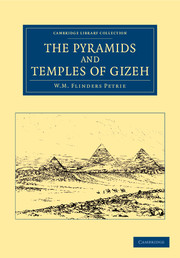
-
Select format
-
- Publisher:
- Cambridge University Press
- Publication date:
- October 2014
- September 2013
- ISBN:
- 9781107325227
- 9781108065726
- Dimensions:
- Weight & Pages:
- Dimensions:
- (244 x 170 mm)
- Weight & Pages:
- 0.46kg, 288 Pages
You may already have access via personal or institutional login
Book description
A pioneering Egyptologist, Sir William Matthew Flinders Petrie (1853–1942) excavated over fifty sites and trained a generation of archaeologists. In 1880 he began the first ever systematic survey of the Giza Plateau, with perhaps his most important work being on the Great Pyramid. Theories abounded as to how the Great Pyramid had been constructed, yet few were based on close examination of the structure itself. Petrie's findings, still used as a reference today, enabled him to disprove prominent theories, such as the belief of Charles Piazzi Smyth that the Great Pyramid was a product of divine revelation and therefore flawless. This first edition of 1883 was not reprinted, and subsequent editions summarised some of the material. Petrie wrote prolifically throughout his long career, and many of his other publications are also reissued in this series.
Contents
Metrics
Altmetric attention score
Full text views
Full text views help Loading metrics...
Loading metrics...
* Views captured on Cambridge Core between #date#. This data will be updated every 24 hours.
Usage data cannot currently be displayed.
Accessibility standard: Unknown
Why this information is here
This section outlines the accessibility features of this content - including support for screen readers, full keyboard navigation and high-contrast display options. This may not be relevant for you.
Accessibility Information
Accessibility compliance for the PDF of this book is currently unknown and may be updated in the future.


